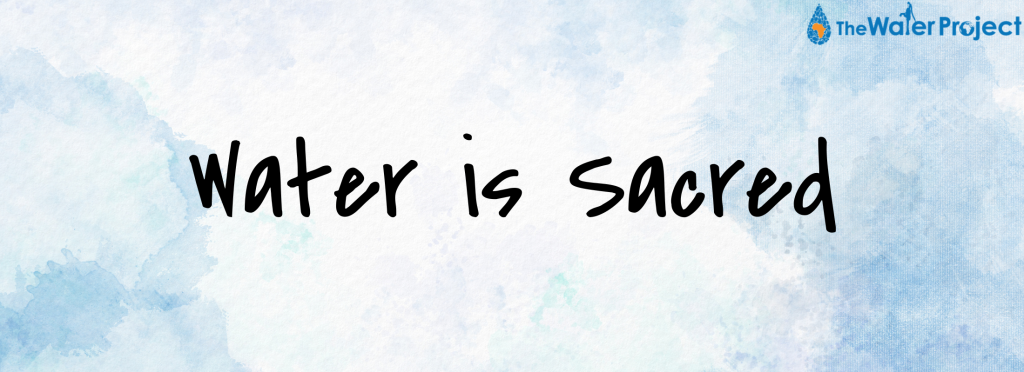Water is Sacred

Just think, for a moment, of how important water is in your life. You need to drink water every day to stay alive. You need water to clean your body, brush your teeth, wash your hands, and dispose of waste inside and outside your body. Water is hugely important, and even imagining life without water is difficult.
It’s no wonder, then, that many humans have come to regard water as sacred. Because there are so many ways humans have revered water throughout history and across the planet, it would be impossible to cover them all in one article. The following snippets constitute just a few interesting examples.
Unfortunately, when learning about these sacred water sources, you find that a good portion of them are now polluted — something we hope changes as more global attention leans toward cleaning up the world and its water.
As you read, consider what water means to you, and what it would feel like if water was scarce (as many sources say it will be within a short period).
Golden Temple — Amritsar, Punjab, India
The Golden Temple, constructed in the 16th century, holds immense significance to Sikh people. It sits in the center of a Sarovar, a holy tank of water that is continuously replenished to maintain its purity. Each month, millions of pilgrims of all nationalities and creeds come to cleanse themselves in the Sarovar, which is also known as the Pool of Nectar.
“The idea of quenching one’s thirst, not only in a physical sense but also in a spiritual and emotional sense, is metaphorically associated with the pool,” said Harnoor Kaur, The Water Project’s Monitoring, Evaluation, Resolution & Learning Associate.
Osun River — Osogbo, Nigeria
Oshun (or Osun), a lesser god called an orisha in Nigerian Yoruba lore, is the goddess of many things, including fertility and water. The legends say that if she is pleased, she will send mild rains to strengthen crops. If she is incensed, she will either withhold her waters entirely (causing a drought) or drown the crops in floods.
In this religion, people believe that Oshun was sent with her fellow orishas to create humanity. All her fellow orishas, all male, failed to do this on their own. Once they persuaded Oshun to help them, she added water to the world and allowed life to flow. Without water, the myth says, there would be no life.
Today, Oshun’s sacred river is still tended by many female devotees, though the river is now polluted by mining practices in the surrounding area.
Whanganui River — Whanganui, New Zealand
The Whanganui River is so revered by the Maori people of New Zealand that they successfully petitioned to grant the river the same rights as a human being in order to preserve the river’s well-being and curb its pollution. Now, any potential development projects along the river’s edge need to be vetted and approved by the tribespeople.
Because of the close ties the tribes had with the river, they have a saying: Ko au te awa. Ko te awa ko au, which means “I am the river. The river is me.”
Blackfeet Nation — Great Plains, Montana
In The Water Project’s service areas, people often say “Water is life.” Imagine my surprise when reading of the Blackfeet tribes of Montana that they said the exact same thing in their own language: Mní wičhóni. But given that the Blackfeet people lived in an arid land where they had to treat water with great respect, perhaps this isn’t all that surprising.
Blackfeet believed that the underwater world is its own sacred realm, called Soyiitapi (alongside the sky and earth realms). They would not fish in their local water bodies or interfere with water bodies in any way. They even held some water animals, like beavers, as divine.
Bagmati River — Nepal
The Bagmati River is mentioned in several different religious texts in the Hindu religion. Its ancient shores once held the promise of reincarnation; for those practicing the Hindu religion in Nepal, a loved one’s body must be dipped in the river’s water three times to officially end their reincarnation cycle. However, this practice has been stagnating recently as the river has grown more and more polluted with sewage and trash.
For many, water is not just a source of sustenance, but a source of healing, blessing, cleansing, and spiritual satisfaction.
We at The Water Project are always trying to treat water with respect. Normally, we approach water conservation from a practical perspective, but there are so many reasons why we should strive to take care of, preserve, and conserve the world’s water, not the least of which are cultural, and even spiritual.
While The Water Project is not cleaning up the world’s polluted water bodies, we are working to spread access to water both equitably and sustainably.
Each time we install a water project, we take into account its ecological impact. We consider whether our boreholes will drain essential aquifers through groundwater management, and whether our sand dams will harm downstream ecosystems (spoiler: they don’t!). We approach each project thoughtfully, and don’t prioritize short-term water access gains over long-term water resource sustainability.
Home More Like ThisTweet